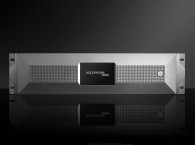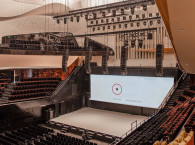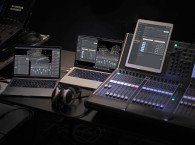
The Holophonix processor brought together several different spatialization techniques including Wave Field Synthesis, High-Order Ambisonics, Distance-Based Amplitude Panning, and more, enabling intuitive placement and movement of sources in a 2D and/or 3D space. Using the highly advanced 2D and 3D sound algorithms designed at IRCAM-based STMS Lab (Sciences et Technologies de la Musique et du Son), located in Paris,
For over twenty years, Amadeus has designed, built and marketed a wide range of electro-acoustical audio playback systems and very high-end signal processing equipment, bringing together high technology, style and emotion. Amadeus was founded in 1992 with the reunion between designer Bernard Byk and scientist Michel Deluc, who led the company's R&D efforts. More recently, Amadeus has been acquired by Gaetan Byk, who over the past 10-years has guided the company and its products to new heights with unique audio speaker designs and one-of-a-kind projects.
The French audio manufacturer is renowned for its live, installed, and custom sound reinforcement and studio systems, and became recognized globally with the unique Philharmonia reference speakers, unveiled in 2014. The Philharmonia speakers were initially created specifically for the Philharmonie de Paris recording and mastering studios, which were built to capture performances by the world's most prestigious symphonic orchestras.
Gaetan Byk, now the CEO and majority shareholder in charge of the French designer and manufacturer, is doubling down on the company's path to innovation, "to go where our main competitors cannot, do not know how to, or do not want to go!” And apart from designing tailor-made solutions, Gaetan Byk is expanding on its collaboration with French research institute IRCAM to turn Amadeus into a leading company in the field of spatial sound for live events and performances. Amadeus’ relationships with IRCAM started in the late 1990s. Over the years, Amadeus has designed more than 339 custom loudspeakers installed within IRCAM’s variable acoustics hall (called Espace de Projection) for research on high-end sound field recreation systems, including Wave Field Synthesis 2D and Ambisonics 3D sound.


A Spatial Audio Foundation
The Holophonix processor has been continuously updated, directly reflecting requests from existing users, most of which are always in very special productions and installations that are normally supported directly by Amadeus. The Holophonix graphical user interface (GUI) has greatly benefited from its field-use and user feedback, while its interoperability has expanded to new encoders and source formats, application servers and applications, OSC controllers, and networked audio systems over Dante. The processor's hardware has also been optimized in order to manage CPU loads and latency according to requirements.
The Holophonix processor is also compatible with the patented em32 Eigenmike HOA (Higher Order Ambisonics) microphone array, developed by MH Acoustics, or with the ZM-1 microphone developed by Zylia. Naturally is also processes all 1st order Ambisonics streams in A-Format and B-Format. It can thus process natively raw signals available directly from Sennheiser AMBEO, SoundField ST250, ST450 or SPS200, RØDE NT-SF1, DPA-4 or Oktava MK-4012 systems. It can also process a generic format source (B-Format) with parameters available to offer compatibility with various formats and standards (FMH, ACN, as well as normalizations FuMa, MaxN, and SN3D).

Now, Amadeus has announced a native macOS application version of its Holophonix immersive sound processor, opening the power of Holophonix to a completely new audience of music and sound creators. The software provides up to 128 inputs, 16 outputs, and all the current features in the original hardware processor. "As sound spatialization needs keep growing, the success met by the Holophonix solution led us to imagine other implementations, to support its democratization and its deployment,” explains Gaëtan Byk.
"The Holophonix Native software is primarily intended for composers, artists, sound engineers, and polymorphic creatives, who wish to produce, compose, and spatialize sound material for a small number of loudspeakers in the studio, live or listening to headphones in binaural," explains Johan Lescure, Head of Holophonix Project Development at Amadeus.
The Holophonix Native software was designed by Amadeus in collaboration with the STMS (Sciences et Technologies de la Musique et du Son) – currently, the most important international laboratory dedicated to research on music and sound sciences, founded in 1995 and housed within the IRCAM (Institut de Recherche et Coordination Acoustique/Musique).

Optimized specifically for macOS 10.15 and subsequent versions and Intel 64/ARM processors, the Holophonix Native software includes all the spatialization techniques already available within the Holophonix 128 processor, including High-Order Ambisonics (2D, 3D) Vector-Base Intensity Panning (2D, 3D), Vector-Base Amplitude Panning (2D, 3D), Layer-Base Amplitude Panning, Wave Field Synthesis, Angular 2D, k-Nearest Neighbor, Stereo Panning, Stereo AB, Stereo XY, Native A-Format Ambisonics, Native-B Format Ambisonics, Binaural, Transaural.
“The performance level provided by the new hardware architectures designed by Apple, allows us to consider using Holophonix Native in live setups, very reliably and with minimal latency, with adapted audio devices," explains Adrien Zanni, Developer at Amadeus. Running a Macs with Apple Silicon, the software offers an almost unlimited number of spatialization buses and virtual sources. The only limitation is the number of physical output channels, limited to 16. Every parameter of the Holophonix processor parameter can be controlled via the Open Sound Control (OSC) protocol. In addition, a virtual audio driver called Holophonix Bridge is available free of charge, allowing inter-application routing without additional latency, and thus a direct connection with almost all DAW like Pro Tools, Nuendo, Ableton Live, Reaper, Logic, QLab, etc.
www.holophonix.xyz
www.amadeuslab.com










